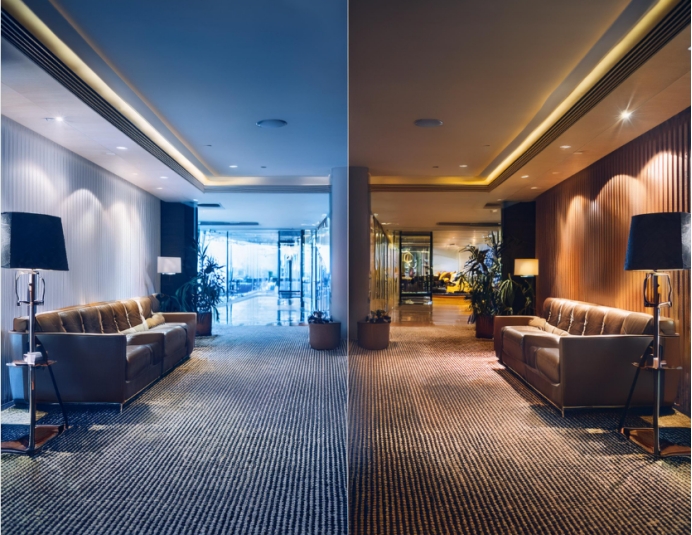- 14
- Aug
Transforming Hotel Lobbies: Modern Lighting Solutions for Day and Night | Expert Insights by Jane Smith, Senior Lighting Designer at LEDER Lighting
Modern Approaches to Hotel Lobby Lighting
Designing or refurbishing a hotel lobby involves careful consideration of the type of hotel, whether it\u2019s a traditional luxury establishment or a contemporary space. The rapid evolution in the hospitality industry means that lighting standards from a decade ago no longer apply to today\u2019s hotel lobbies.
The lobby serves as the hotel’s introduction to guests, setting their first impression. Effective and inviting lighting enhances interactions between guests and staff, smoothing the check-in process and creating a pleasant atmosphere.
Key Considerations in Lobby Lighting Design
-
Human-Centric Lighting
Human-centric lighting focuses on the relationship between people and light, aiming to enhance comfort and well-being. Effective lobby lighting design starts with understanding how different lighting conditions impact guests throughout the day. The goal is to create a visual environment that caters to guests\u2019 varying needs from morning check-in to evening relaxation.

- Daytime Lighting: During the day, maximizing natural light creates a vibrant atmosphere. Large windows or skylights allow daylight to flood the lobby, while supplementary lighting should complement this natural light to ensure a balanced and warm environment.
- \u00a0\u00a0Nighttime Lighting: As daylight fades, the lighting should transition to warmer, softer tones. This shift helps create a relaxing ambiance and reduces the stark contrast between outdoor brightness and indoor lighting. Dim ambient lighting combined with accent lighting can enhance comfort and relaxation.
- \u00a0\u00a0Adjustable Lighting: Providing options to adjust lighting levels allows guests to tailor their experience. Dimming switches and multi-zone lighting systems can accommodate different activities and preferences, from bright, lively check-in areas to softer, more intimate seating arrangements.
-
Adapting to Modern Hotel Design
Modern hotels often feature innovative and unique design elements that challenge traditional categories. Lighting designers must adapt their approaches to fit these diverse styles, whether aiming to make a bold statement or create a tranquil retreat.

- Unique Design Elements: Modern hotel lobbies may incorporate unconventional architectural features, such as sculptural installations or art wall treatments. Lighting should highlight these elements, using wall washers or accent lighting techniques to draw attention and enhance visual impact.
- \u00a0\u00a0Versatile Atmospheres: Lighting design must be adaptable, able to transition from bright and vibrant to soft and atmospheric. This adaptability ensures the lobby can serve various functions, from busy morning check-ins to quiet evening gatherings.
- \u00a0\u00a0Integrated Technology: Incorporating smart lighting systems can further enhance the flexibility of modern hotel lobbies. Automated controls and programmable settings allow for dynamic adjustments based on the time of day or occupancy levels, optimizing energy efficiency and guest comfort.
-
Collaborative Design Process
Effective lighting design is a collaborative effort between lighting designers and interior designers. This partnership ensures that the lighting plan aligns with the overall aesthetics and functional goals of the space.

- Cohesive Design: Through collaboration, designers can achieve a unified look that complements the interior d\u00e9cor. Lighting choices should harmonize with color schemes, furnishings, and architectural elements, enhancing the overall visual appeal.
- \u00a0\u00a0Functional Integration: Beyond aesthetics, lighting must meet the functional needs of the lobby. This includes providing adequate illumination for reception areas, seating zones, and pathways while creating focal points and visual interest.
- \u00a0\u00a0Feedback and Refinement: Regular communication and feedback between designers help refine the lighting plan. Adjustments based on practical considerations and guest feedback ensure that the final design meets both visual and functional expectations.
-
\u00a0Lighting Insufficiency and Guest Comfort
A critical aspect of lobby lighting design is ensuring adequate illumination to prevent discomfort caused by insufficient lighting. While poor lighting might not be immediately noticeable on cloudy days, transitioning from bright outdoor environments to poorly lit indoor spaces can become problematic.

Visual Discomfort: Guests may experience visual discomfort when moving from a well-lit outdoor area to a dimly lit lobby, leading to eye strain and negatively impacting their overall perception of the hotel.
Case Studies
- Case Study 1: A luxury hotel in Paris received complaints from guests about eye strain upon entering the lobby. The solution involved increasing overall lighting levels and incorporating transition lighting elements to ease the shift from outdoor to indoor environments.
- Case Study 2: A boutique hotel in New York faced similar lobby lighting insufficiency issues. The redesign included installing adjustable lighting systems and ambient fixtures to provide more comfortable and gradual light level changes.
- Case Study 3: A resort in Bali encountered the problem of guests feeling disoriented when transitioning from bright outdoor spaces to the lobby. The solution involved introducing a combination of indirect lighting and natural light sources to create a smoother transition.
- Case Study 4: A city hotel in Tokyo found that inadequate lobby lighting affected guests’ first impressions. The redesign focused on enhancing ambient and task lighting to ensure a warmer and visually comfortable environment.
- Case Study 5: A modern hotel in London was troubled by insufficient lobby lighting affecting guest comfort. The renovation included a layered lighting strategy and improved light sources to effectively address the issue.
Conclusion
Lobby lighting design plays a crucial role in shaping the guest experience. As hotels evolve, lighting approaches must adapt accordingly. By focusing on human-centric design, collaborating with interior designers, and accommodating modern needs, hotels can create lobbies that are welcoming, functional, and visually stunning, leaving a lasting impression on guests.
____________________________________________________________________________________________________________________
Design Contributions
This design approach was led by Jane Smith, Senior Lighting Designer at LEDER Lighting. With over 15 years of experience in hospitality lighting design, Jane specializes in creating innovative and functional lighting solutions that enhance the guest experience while aligning with contemporary design trends. Her expertise in balancing aesthetics and practicality ensures that hotel lobbies are not only visually appealing but also meet the needs of modern guests.
For more information or to discuss your hotel’s lighting needs, please contact Jane Smith at LEDER Lighting.
